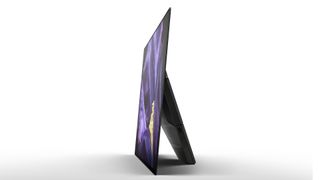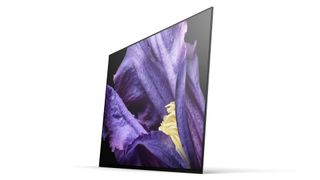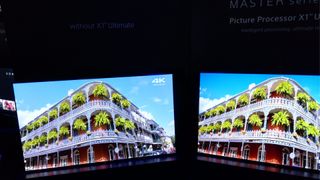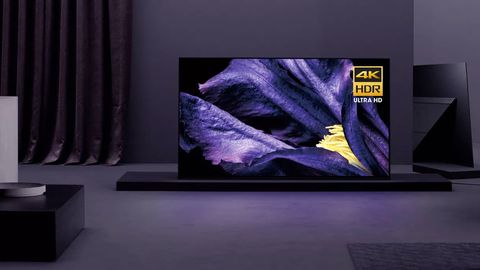Hands on: Sony Bravia A9F OLED (XBR-65A9F) review
OUR EARLY VERDICT
Part of Sony's Master Series, the Sony Bravia A9F OLED looks absolutely brilliant. Even better, as it's coupled with an enhanced version of its Acoustic Surface Audio technology, it sounds ridiculously good, too.
FOR
- X1 Ultimate image processor
- Audio+ sound system
- Android Oreo smart platform
AGAINST
- Lean back design
- Reworked image presets
Sony’s second-generation OLED flagship, the A9F, is coming at a good time – just as Samsung and LG have stepped up their games with the Samsung Q9FN QLEDand LG E8 OLED, Sony has fired back with a phenomenal OLED of its own.
The A9F is a poster boy for Sony’s new Master Series TVs, an appellation to signify premium performance, and is joined by the Z9F, a high performance LED-LCD TV, which is an update on the much-lauded Sony Bravia Z9D.
At Sony’s recent global Master Series launch in New York, we had a chance to spend some quality time with the A9F, comparing various aspects of its feature spec, and benchmarking it against competitors and comparable Sony screens.
While our demos with Sony's next-gen screen we were limited, what we saw was enough to get us salivating for a review sample all our own.
Price and release date
The A9F is available in two screen sizes, 55- (XBR-55A9F) and 65-inches (XBR-65A9F) – however we spent time with the latter. Prices have yet to be announced for either model, but we’re pretty confident both will land with hefty price tags.

Design
The A9F adopts the same lean back design as its predecessor, the Sony Bravia A1E OLED, although there are changes to the kickback stand. As a consequence it doesn’t seem to lean quite so far back and the set can also be wall-mounted, if preferred.
In terms of design, the biggest improvement comes in the implementation of Sony’s vibrating sound tech, Acoustic Surface Audio+, that adds a third on-screen actuator to create a centre channel between the previous stereo configuration. Also included is a second bass driver, effectively creating a 3.2 sound system. All three actuators are incorporated into the lean back stand, along with the twin bass drivers.
The upgrade sounds remarkable. Dialogue is clear and locked to the screen, and the additional bass driver adds weight. There was also clear channel steerage around our 65-inch screen.

The sound system also has a line input, which allows you to use the screen as a centre channel in a multichannel sound system. The execution is odd, as all the drivers are aggregated as one, and have to be reamplified by the set’s own amplifier modules. To demo this, we were treated to clips from The Greatest Showman, with the screen acting as centre, and then compared with a standard centre speaker located below the screen.
This arrangement is rather cute, particularly as a compromise solution when you can’t accommodate a physical centre speaker. However there are obvious tonal differences across the L/C/R. The set’s own amplification, optimistically quoted at 98W, also makes it impossible to use if the rest of a home cinema is running at reference level. Still, as a tweak on a living room surround layout, it’s rather useful.
Performance
Picture quality often had us gasping. The X1 Ultimate chipset introduces some new processing wrinkles which amplify existing picture detail without adding any unwanted edge enhancement. Object-based Super Resolution and Object-based HDR Remaster work on individual elements in the picture, without amplifying the entire frame. The end result is an picture that pops with detail and nuance.
There’s also a new Pixel booster at play, designed to lift color and contrast.
The set supports HDR10, HLG and Dolby Vision and its HDR performance looks to be on par with the older A1.
Operationally, the new A9F would seem to be a slightly different beast to its predecessor and Sony has done well to rework some of its image presets. Cinema Pro mode has been replaced with a new version of Custom, for example, which features Reference settings, but allows for customization.
Sony always played its ‘lens to living room’ card, rightly extolling the fact that its hardware is involved at every level when it comes to movie making. But this year it’s taken a leaf from the Panasonic playbook, and is really going to town on the ‘creators intent’ angle. The phrase was dropped at every opportunity.

Advertisement
It also staged multiple demonstrations of the set running alongside a Sony BVM-X300 pro-OLED monitor, in order to prove just how close it could get to studio grade images.
The A9F’s ability to resolve near black detail was hammered home by a shadowy scene in Crouching Tiger, Hidden Dragon. Given that many of our A9F demos were staged in near total darkness, the panel often appeared to vanish completely; such was its inky authenticity.
Also new, and exclusive (for the time being) to Sony’s Master Series, is a Netflix Calibrated Mode. This custom preset can only be supplied to the set’s internal Netflix app and supposedly optimizes the screen for the best possible Netflix image, by mimicking the settings on Netflix mastering monitors.

Lost in Space Executive Producer Zack Estrin was on hand to endorse the initiative. But as far as we could make out, the setting isn’t driven by metadata and is basically just a generic recipe – so our expectations, at this point, are low.
Interestingly, Sony made very little of the fact that the screen will also land with the new Android Oreo TV OS. Given how inelegant Android has been to date, this is actually a rather exciting prospect. Certainly the new UI looks far cleaner and more manageable than what we’ve experienced so far. It’s a definite step forward.
Early verdict
There are several genuine reason to get very excited by the A9F: The debut of the X1 Ultimate processor appears to herald a significant evolution in picture processing, which not only makes 4K shine but also makes lesser sources diamond sharp. And, on top of that, the arrival of Acoustic Surface Audio+ lends this Sony a sonic edge that no one can match. Could that make the A9F the new king of OLED? We won’t have long to wait to find out.
- Will the Sony A9F join our list of the best 4K TVs? Only time will tell...





Comments
Post a Comment